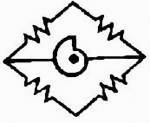
The trade mark shows a CAM surrounded by a BRIDGE of resistors.
from 1881 to 1988
(especially as it relates to other items in my collection)

The trade mark shows a CAM surrounded by a BRIDGE of resistors.
The Company was formed in 1881 as The Cambridge Scientific Instrument Company by Horace Darwin [1851-1928] Charles Darwin's ninth and youngest son, to supply the laboratories of Cambridge University. The Darwin family association continued until the 1970s. The firm started in Panton Street before moving to St Tibbs Row in 1882. It became a Limited Liability Company in 1895 when it moved to new larger premises in Carlyle Road. In December 1919 the company took over the R. W. Paul Instrument Company of Muswell Hill London and the name changed to The Cambridge and Paul Instrument Company Ltd. The name was shortened to the Cambridge Instrument Co Ltd in 1924 when it was converted to a public company.
The company was sold to George Kent in 1968 and after the merger it was organised into four divisions, each being eventually separately sold off. The premises in Newton Avenue and the adjacent Sydney Street in Muswell Hill remained in use until 1975 when the company moved to St Neots in Cambridgeshire. In 1974 the Kent Group combined with BBC [Brown Boveri & Co. Ltd], the latter merged with the Swedish firm ASEA in 1988 to form ABB Group.
Many ex-company employees either founded other well known companies or gained important positions in them. William T. Pye, who had joined as foreman in 1880 left in 1898 to form the W.G. Pye Instrument Company with his son, ultimately to branch out into Pye Radio Ltd.. E. I. Everett joined with Edgecumbe to form Everett Edgecumbe Ltd.
Robert William Paul (1869-1943) who had previously worked for Elliott Bros trained as a scientific instrument maker at City and Guilds College in London. He set up in business in Hatton garden in 1891, producing a range of instruments, mostly electrical. In 1903 he introduced the 'Unipivot' galvanometer. This was a robust, easy-to-use, single pivot moving-coil very sensitive instrument. About this time the business moved to a new factory at Newton Avenue Works, New Southgate, London N10 [This is now part of Muswell Hill.] The 'Unipivot' galvanometer proved to be very successful and within a few years a large number of variants and accessories for a wide range of electrical measurement were being made. They were assembled from the large-scale manufacture of identical and interchangeable parts that could be assembled economically.
Robert Paul continued to work within the enlarged organisation for the rest of his life. He also became a cinematic pioneer in the 1890s. For some interesting history on this aspect see here:www.screenonline.org.uk and here://www.thecinetourist.net/my-local-filmmaker.html
Eric Balliol Moullin, [1893-1963] was a Cambridge Professor of Electrical Engineering and President of the Institution of Electrical Engineers [IEE]. He invented the first vacuum-tube voltmeter which he described in a paper to the IEE in December 1922. It was manufactured and marketed by the Cambridge Scientific Instrument Company. Several versions were produced: a pattern A voltmeter for AC and DC use, a pattern B, a pattern C (double range), a pattern D (AC), and a pattern P(with a probe).
Further reading
Much more information about this remarkable firm can be found in
this book:
"Horace Darwin's Shop" by Cattermole, M and Wolfe,A, Adam
Hilger, pp285.1987